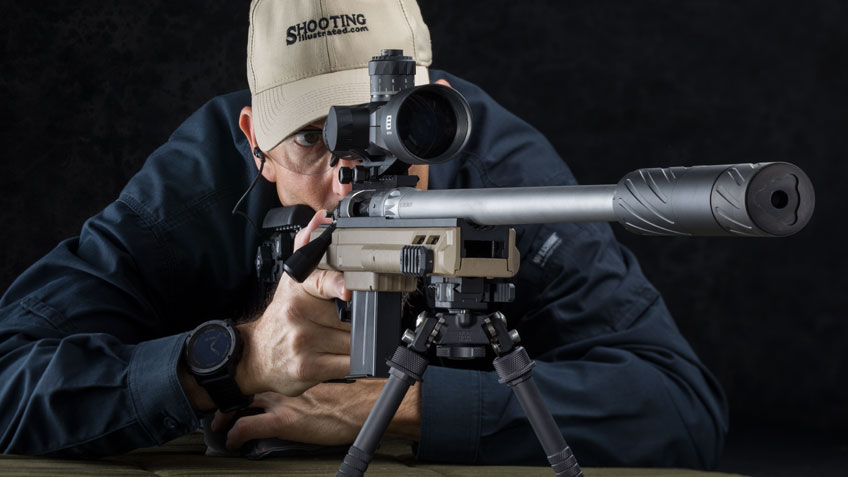
The world of long-range rifle shooting has undergone a metamorphosis in recent years. Not so long ago, it was the “nutty uncle” of the shooting family. In polite company, the practitioners sat alone in the corner and mumbled to themselves about the Coriolis effect, ladder tests and standard deviation.
Then, something happened. Long range went mainstream. The explosion of PRS competition helped, but there was more than that. Long-range shooting became the cool guy. It seems like everybody is doing it, and rifle makers are taking note. When Ruger introduced its RPR at a working man’s price, the long-range market changed—drastically. Since then, we have seen a glut of “price point” rifles as manufacturers race to provide accurate rifles at affordable prices.
Rock River Arms built its reputation on quality semi-automatic AR-pattern rifles and 1911 handguns. This new growth market was not lost on the company, so it decided to enter the precision-rifle world. Rather than compete on price point, however, it decided to introduce a rifle on the other end of the spectrum—a place where there is much less competition. While it’s still a few bucks less than a full-blown custom rifle, the RBG-1S (Rock Bolt Gun first generation, short action) is scratching at the roof of the production-rifle price structure.
The folks at Rock River Arms call the RBG-1S rifle a “Custom Production” rifle, meaning you can order yours to be built to your specs. For example, you can order custom features such as a different barrel length or a Timney trigger rather than a Trigger Tech trigger. I was a bit surprised when I opened the box and found that the rifle uses a barrel nut similar to the Savage Model 110 design. I know that a barrel nut is a big factor in cutting manufacturing expense, and it’s a fan favorite for the DIY guys building the “Remage” hybrid rifles. This design has proven to be quite accurate in production guns with Savage and other rifle brands, but I have never seen it used in a high-end precision rifle.

The idea behind Rock River’s decision to go with a barrel-nut design is traditional in that it makes manufacturing easier and it allows for precise headspace control. It’s also addressing the concerns of a serious, hardcore long-range shooter. The barrel-nut design makes replacing the barrel easy, and a handy shooter can swap barrels with only a few tools.
The theory is a serious shooter will shoot out the barrel regularly, often in a single season. With the barrel nut, the shooter can replace the barrel without paying a gunsmith. It also allows the gun owner to switch cartridges. The bolt uses a replaceable bolt head, so it can also be easily switched. If, for example, your rifle is now a .308 Win. and you decide you want a 6.5 PRC, you simply swap out the bolt head and the barrel, pick up some new magazines and shazam, you have a 6.5 PRC rifle. Can’t find ammo? It’s back to .308 Win. in half an hour.
The proof is always at the target range. In this case, the rifle is very accurate, although it did exhibit a few quirks. The RBG showed a defined preference for certain ammunition, and with ammo it likes it shot very well—although it did have a propensity to throw a flyer now and then. Because I can’t be sure that it’s the rifle and not the shooter or the ammo, I would shoot a sixth shot, which invariably would impact in the main group. It did this with two out of the three ammunition types I tested. In both sets, I got fliers in three out of the five groups. They seemed to be random as to which shot turned rogue, with no discernible pattern.
Both choices were the remnants of case lots of ammunition I have used in other rifles without experiencing fliers. The third ammo product, American Eagle 140-grain OTM, did not shoot as well in this gun, despite having performed very well in other precision rifles. This situation is not uncommon—sometimes a certain rifle and ammo just don’t like each other. It’s nobody’s fault. I would say “think of the children” but there aren’t any. Well, maybe that .308, but with a little therapy, it will be fine.

I think much of this target drama was simply that the rifle needs some bullets downrange for it to stabilize. The more I shot the rifle, the better it was shooting. I think it needed a “settling in” period, perhaps more than usual due to the barrel nut design—I don’t know for sure, but it’s a theory. The nut adds in another set of threads to the equation, so it’s a possible explanation.
The barrel-nut design makes replacing the barrel easy, and a handy shooter can swap barrels with only a few tools.
I threw out the first group as I didn’t feel it was representative of the rifle’s performance. Instead, I used the second through sixth groups for the Hornady ammo data. Because it was the first ammo tested, I think the Hornady 140-grain ELD-M probably should have had a better overall showing.
This load is a consistent half-MOA performer in most rifles. Even after throwing out the first group, the remaining five groups got progressively smaller the more I shot. The first group I counted was 1.25 inches and the last .3 inches. Because of time constraints and ammo shortages, it was not possible to retest this ammo. My guess is it would be half-MOA now that the rifle has settled.
This illustrates one of the problems with testing rifles under a tight editorial deadline and the dilemma writers face. We want to provide the most fair and accurate evaluation of the rifle. Most rifles need a little breaking-in time before they reach their peak performance. Ideally, I would have shot this rifle a bunch more before doing the formal accuracy test. Also, in this time of panic buying, finding the ammo to do that is a bit of a problem, too.
No matter, as long as there is something to feed it, this rifle will perform. I feel confident in saying that with ammo that it likes, the RBG-1S is a clear and consistent half-MOA rifle. Everybody claims that, but this one will deliver. I will note that the hotter this rifle became, the better it would shoot. Some of the best groups were shot with the barrel too hot to touch. This is important in a precision rifle: They must shoot hot without expanding the groups or shifting point of impact, or they are worthless when it counts.
The RBG-1S’ bolt uses a common extractor style fitted in a slot on the right lug with a ball and detent under spring pressure. The bottom of the bolt is open, reminiscent of the Winchester oxymoronically named controlled-round, push-feed design. In the RBG, the extractor captured some cartridges, and some it did not, so I don’t know if you would call it a controlled-round feed or an intermittent-controlled-round feed. It really doesn’t matter. During all of my testing I fed cartridges from the magazine and I ran the bolt hard much of the time. It ran smooth and fast with zero problems. The ejector is a standing style in the action similar to the 1903 Springfield design. Ejection is controlled by the bolt speed, so you can toss them well clear or capture them in a neat pile beside you, depending on how fast you run the bolt.

The bolt head is replaceable and is pinned to the bolt body. Its two-lug design has a second set of lugs behind the main bolt lugs that are .155-inch thick. Secondary lugs are floating and pivot on the bolt. It’s held in place by a spring washer holding tension. The theory is that somehow the lugs float to help compensate for any tolerance gaps when the bolt locks into the receiver.
The black bolt body has shallow-spiral flutes. The oversize bolt handle is held on with a 1⁄4x28 screw, which is smaller than the conventional 5⁄16 thread found on most oversize bolt handles. But, unless you have a Wookie running the bolt, it should be more than strong enough. There is a cocking indicator on the back of the bolt.
Made by Wilson Arms, the 24-inch stainless steel barrel is button-rifled. It’s air-gauged and cryo-treated, which may be why it shoots so well when hot. Cryogenic treatment places the barrel into an extremely cold environment, -300 degrees Fahrenheit (about the same as a January night in Vermont) for a period of time. This is said to align the molecules in the metal and remove any memory in the steel. This in turn keeps the barrel stable throughout a range of temperatures while shooting.
The barrel is a heavy contour, measuring 1.062 in front of the barrel nut and .835-inch behind the muzzle threads. The muzzle is threaded 5⁄8x24 for a brake or suppressor, but comes with a thread protector. At this price point, I would have expected a brake to be included. The thread protector screws down on a rubber O-ring to hold it in place. I’m not sure why.
The stainless steel action is a Remington 700 footprint that is made to Rock River’s specifications. The bolt release is on the left side of the action, above the ejector. There is a 20-MOA rail included and fitted on top with #8 screws. On that, I installed a Tract Toric 4-20X tactical scope. The adjustable Trigger Tech trigger uses a two-position safety and does not lock the bolt shut. It broke very crisply at 2 pounds, 12 ounces. The barrel and action are a bead-blasted, light-matte finish, and the bolt is black.
 The rifle is fitted with a KRG Whiskey-3 chassis compatible with AICS-style detachable-box magazines. Color options include tan, black and green. This chassis has an aluminum bedding base, is adjustable for length-of-pull and has an adjustable cheekpiece.
The rifle is fitted with a KRG Whiskey-3 chassis compatible with AICS-style detachable-box magazines. Color options include tan, black and green. This chassis has an aluminum bedding base, is adjustable for length-of-pull and has an adjustable cheekpiece.
The thick recoil pad is also adjustable for attitude and can be turned left or right to fit the shooter’s preference. All adjustments are made with finger knobs, so no tools are needed. That said, I had to use a wrench to hold the screw so I could tighten the length-of-pull knob, which is why it is prudent to always bring a tool kit.
There is a base pad on the rear for support and a sling-swivel stud on the front near the end of the fore-end to mount a bipod. The wide, flat fore-end sat quite solid on the sandbag on my machine rest. There are quick-detach, sling-swivel pockets on the front and rear of the left side of the chassis. The right side has a pocket in the rear. The front has the hole and screw for the metal pocket, but it’s not installed. The chassis has a bunch of 10x32 threaded holes scattered in groups around the fore-end, presumably to mount accessories.
The rifle is currently offered in 6.5 Creedmoor (keeping with intergalactic law that says all new rifles must be in this chambering) and .308 Win. There are plans to add more cartridges, so if you wish for something else, it might be good to make a phone call and see if Rock River Arms can do it.

I’ll be honest. When I first saw Rock River’s first attempt at a bolt gun, I was skeptical. But, after shooting it and thinking more about the reasons for the design, I have become a fan. This is probably not the rifle for a casual shooter, but for a serious long-range aficionado who does not want to spend six or seven grand on a full-blown custom rifle, the RBG-1S is an excellent alternative.





































